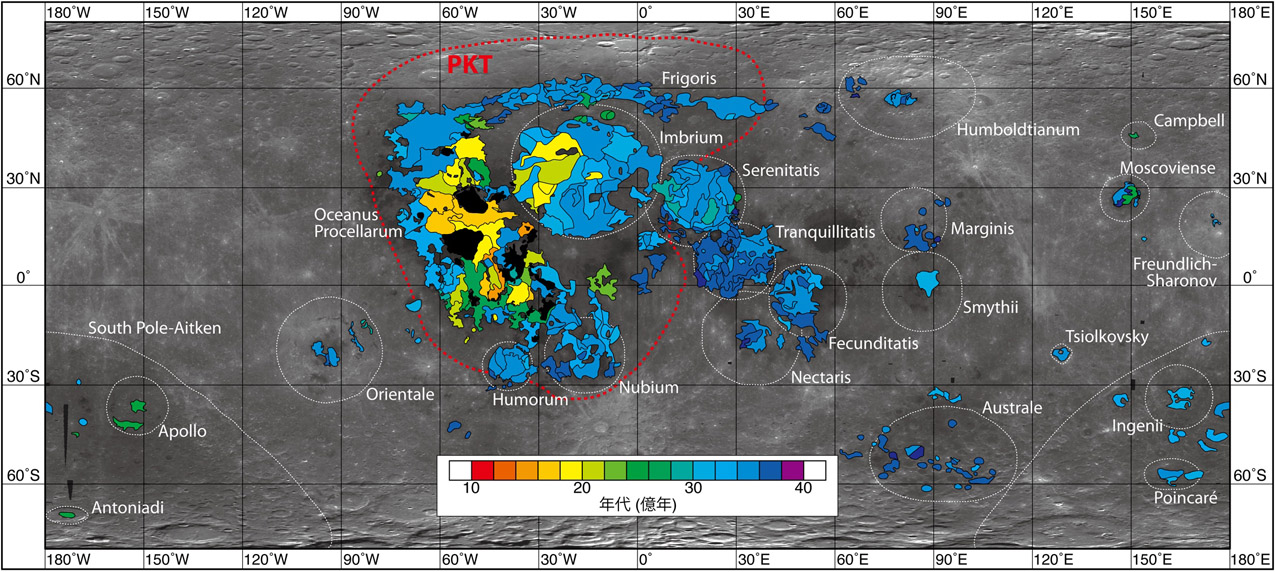April 28, 2012
Long Time Hot

image by Morota and colleagues, 2011
Scientists have samples of lunar rocks from the 6 Apollo landing sites and the 3 successful Luna sample return missions.
From those samples we know the age of formation of rocks at 9 places on the Moon, although there is some uncertainty
about what geologic event each rock dates. And yet this map proports to show the ages of nearly all lunar maria (except
for Crisium). This is achieved by the conceptually straightforward process of counting impact craters on lava flow surfaces.
The odd shapes of different colored - and aged - rocks is because counting is segregated by areas that appear to have
chemically homogeneous signatures, evidence that the rocks may be a single eruptive unit. This map combines the crater
count age dating of Harry Hiesinger and colleagues with the more recent counting of mare patches by Japanese scientists
using the high resolution Terrain Camera of the Kaguya spacecraft. Interpret the distribution of lavas of different ages and
then come back to resume reading.
Most of the colored area is blue, meaning that much of the lunar maria we see was emplaced between about 3.8 and 3.0
billion years ago. Old lavas are most commonly exposed in the eastern mare, and younger ones are largely restricted to
the western maria, essentially Procellarum and western Imbrium. Over 2.5 b.y., volcanism seems to have migrated from
the east (Marginis and Australe) to the southwest. But this may be a selection effect. Small patches of old (blue) lavas stick
out around the edges of younger lavas, and presumably are buried under them. A more likely conclusion is that older lavas
occured on basin floors everywhere, but younger lavas preferentially erupted only in the west, concealing older lavas in
those areas. Morota and colleagues point out that the youngest lavas are restricted to the inner part of the PKT, the Procellarum KREEP Terrain, which is anomalously rich in radioactive elements, perhaps prolonging mantle melting after it stopped
elsewhere. Note that lunar basins formed before 3.8 b.y. so most of the lavas are not related to the energy of impacts that
formed the basins, but rather - presumably - to radioactive heating that melted the mantle over 2.5 to 3.0 billion years. Volcanic eruptions continued on the Moon up to about 1.5 b.y. ago. Humans came on the scene rather late for the best views.
Chuck Wood
Notice that the oldest rocks in Nectaris are exactly along the ray that seems to come from Tycho. Secondary craters are
meant to be excluded in crater counts - perhaps some were missed here.
Another comment - It would be wonderful if someone could transfer these colors (from the full res map to the LRO WAC
map, preferably making the colors partially transparent. That would allow better understanding of which units have which ages.
Related Links
Tomokatsu Morota and colleagues (2011) Timing and characteristics of the latest mare eruptions on the Moon. Earth and
Planetary Science Letters 302, 255–266.
Yesterday's LPOD: Slender Sliver
Tomorrow's LPOD: Southern Bumps
COMMENTS?
Register, Log in, and join in the comments.



